 W
WAcanthophis is a genus of elapid snakes. Commonly called death adders, they are native to Australia, New Guinea and nearby islands, and are among the most venomous snakes in the world. The name of the genus derives from the Ancient Greek akanthos/ἄκανθος ('spine') and ophis/ὄφις ('snake'), referring to the spine on the death adder's tail.
 W
WThe African clawed frog is a species of African aquatic frog of the family Pipidae. Its name is derived from the three short claws on each hind foot, which it uses to tear apart its food. The word Xenopus means "strange foot" and laevis means "smooth".
 W
WAgama is the name of a genus of small-to-moderate-sized, long-tailed, insectivorous Old World lizards, and also is one of their common names. The genus Agama includes at least 37 species in Africa, especially sub-Saharan Africa, where most regions are home to at least one species. Eurasian agamids are largely assigned to genus Laudakia. The various species differ in size, ranging from about 12 to 30 centimetres in length, when fully grown.
 W
WAn alligator is a crocodilian in the genus Alligator of the family Alligatoridae. The two extant species are the American alligator and the Chinese alligator. Additionally, several extinct species of alligator are known from fossil remains. Alligators first appeared during the Oligocene epoch about 37 million years ago.
 W
WAnolis is a genus of anoles, iguanian lizards in the family Dactyloidae, native to the Americas. With more than 425 species, it represents the world's most species-rich amniote tetrapod genus, although it has been proposed that many of these should be moved to other genera, in which case only about 45 Anolis species remain. Previously, it was classified under the family Polychrotidae that contained all the anoles as well as Polychrus, but recent studies place it under Dactyloidae.
 W
WAntennarius is a genus of 11 species of fish in the family Antennariidae. These fish spend most of their lives on the bottom in relatively shallow water between 20 and 100 m. They can be found worldwide in tropical and subtropical waters. They are well-camouflaged ambush predators that wait for prey fish to pass by. They have "lures" which they move to attract the prey. They have little economic value other than a minor role in the aquarium trade. Commerson's frogfish was the first species in this genus to be described, in 1798.
 W
WBosc's fringe-toed lizard or Bosk's [sic] fringe-fingered lizard is a species of lizard in the family Lacertidae. The species is endemic to North Africa and Western Asia. Three subspecies are sometimes recognised; A. boskianus boskianus, from Lower Egypt; A. boskianus euphraticus from Iraq; and A. boskianus asper from the rest of the range; however this division is unsatisfactory because each subspecies has much variation and the differences between them are not consistent.
 W
WThe broad-snouted caiman is a crocodilian reptile found in eastern and central South America, including southeastern Brazil, northern Argentina, Uruguay, Paraguay, and Bolivia. It is found mostly in freshwater marshes, swamps, and mangroves, usually in still or very slow-moving waters. It will often use man-made cow ponds.
 W
WBungarus is a genus of venomous elapid snakes, the kraits, found in South and Southeast Asia. The genus Bungarus has 15 species.
 W
WThe broad-snouted caiman is a crocodilian reptile found in eastern and central South America, including southeastern Brazil, northern Argentina, Uruguay, Paraguay, and Bolivia. It is found mostly in freshwater marshes, swamps, and mangroves, usually in still or very slow-moving waters. It will often use man-made cow ponds.
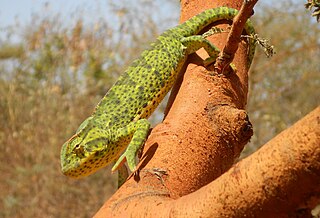 W
WThe Senegal chameleon, Chamaeleo senegalensis, is a species of chameleon native to West Africa. Its range includes Senegal, Mali, Nigeria, and Cameroon, and it lives in moist savanna. Due to its wide range and unknown population, the Senegal chameleon is listed as Least Concern by the IUCN Red List. However, it may be threatened by the pet trade. The Senegal chameleon is usually olive brown, and ranges from 20 to 30 cm in length, although the male is usually smaller.
 W
WCorallus, the neotropical tree boas, are a genus of boas found in Central America, South America and the West Indies. Nine extant species are recognized as of 2017.
 W
WThe genus Dracaena, also called caiman lizards or water tegu, is in the teiid family, along with tegus and ameivas. Caiman lizards are found in South America in Ecuador, Colombia, Paraguay, Peru and Brazil. These semiaquatic lizards spend a lot of time in the water and inhabit marshes, streams and flooded forests. Caiman lizards often bask on branches overhanging the water.
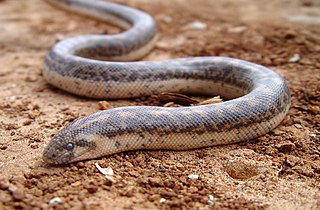 W
WEryx is a genus of nonvenomous boas known as Old World sand boas. They are found in southeastern Europe, northern Africa, the Middle East, and southwestern Asia. Nine species are currently recognized.
 W
WEumeces schneiderii, commonly known as Schneider's skink or the Berber skink, is a species of lizard in the family Scincidae. The species is endemic to Central Asia, Western Asia, and North Africa. There are five recognized subspecies.
 W
WThe eastern fence lizard is a medium-sized species of lizard in the family Phrynosomatidae. The species is found along forest edges, rock piles, and rotting logs or stumps in the eastern United States. It is sometimes referred to as the prairie lizard, fence swift, gray lizard, northern fence lizard or pine lizard. It is also referred to colloquially as the horn-billed lizard.
 W
WThe hellbender, also known as the hellbender salamander, is a species of aquatic giant salamander endemic to the eastern and central United States. A member of the family Cryptobranchidae, the hellbender is the only extant member of the genus Cryptobranchus. Other closely related salamanders in the same family are in the genus Andrias, which contains the Japanese and Chinese giant salamanders. The hellbender, which is much larger than all other salamanders in its geographic range, employs an unusual means of respiration, and fills a particular niche—both as a predator and prey—in its ecosystem, which either it or its ancestors have occupied for around 65 million years. The species is listed as Near Threatened on the IUCN Red List of Threatened Species.
 W
WLachesis, also known as bushmasters, is a genus of venomous pit vipers found in forested areas of Central and South America. The generic name refers to one of the Three Fates, Lachesis, in Greek mythology who determined the length of the thread of life. Four species are currently recognized.
 W
WThe many-horned adder is a venomous viper species found in certain rocky desert areas, mostly along the Atlantic coast of southern Africa. They have characteristic tufts of "horns" above each eye. no subspecies are currently recognized.
 W
WThe marbled leaf-toed gecko is a gecko found in southern and southwestern South Africa and in Namibia. It is a flat, medium-sized gecko.
 W
WThe martial eagle is a large eagle native to sub-Saharan Africa. It is the only member of the genus Polemaetus. A species of the booted eagle subfamily (Aquilinae), it has feathering over its tarsus. One of the largest and most powerful species of booted eagle, it is a fairly opportunistic predator that varies its prey selection between mammals, birds and reptiles. Its hunting technique is unique as it is one of few eagle species known to hunt primarily from a high soar, by stooping on its quarry. An inhabitant of wooded belts of otherwise open savanna, this species has shown a precipitous decline in the last few centuries due to a variety of factors. The martial eagle is one of the most persecuted bird species in the world. Due to its habit of taking livestock and regionally valuable game, local farmers and game wardens frequently seek to eliminate martial eagles, although the effect of eagles on this prey is almost certainly considerably exaggerated. Currently, the martial eagle is classified with the status of Endangered by the IUCN.
 W
WThe northern caiman lizard is a species of lizard found in northern South America.
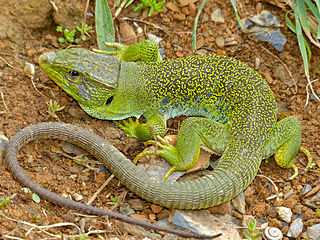 W
WThe ocellated lizard or jewelled lizard is a species of lizard in the family Lacertidae. The species is endemic to southwestern Europe.
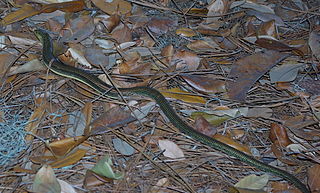 W
WOphisaurus is a genus of superficially snake-like lizards in the family Anguidae. Although most species have no legs, their head shapes, movable eyelids, and external ear openings identify them as lizards. A few species have very small, stub-like legs near their rear vents. These are vestigial organs, meaning they once served an evolved purpose but are no longer used. They reach lengths of up to 1.2 metres (4 ft), but about two-thirds of this is the tail. Glass lizards feed on insects, spiders, other small reptiles, and young rodents. Their diets are limited by their inability to unhinge their jaws. Some glass lizards give birth to live young but most lay eggs.
 W
WThe yellow-bellied sea snake is a venomous species of snake from the subfamily Hydrophiinae found in tropical oceanic waters around the world except for the Atlantic Ocean. For many years, it was placed in the monotypic genus Pelamis, but recent molecular evidence indicates it lies within the genus Hydrophis.
 W
WThe yellow-bellied sea snake is a venomous species of snake from the subfamily Hydrophiinae found in tropical oceanic waters around the world except for the Atlantic Ocean. For many years, it was placed in the monotypic genus Pelamis, but recent molecular evidence indicates it lies within the genus Hydrophis.
 W
WPituophis melanoleucus, commonly known as the pine snake, is a species of nonvenomous snake in the family Colubridae. The species is endemic to the southeastern United States. Three subspecies are currently recognized as being valid.
 W
WThe Puerto Rican woodpecker is the only woodpecker endemic to the archipelago of Puerto Rico and is one of the five species of the genus Melanerpes that occur in the Antilles. Furthermore, it is the only resident species of the family Picidae in Puerto Rico. The species is common on the main island of Puerto Rico and rare on the island of Vieques.
 W
WPython is a genus of constricting snakes in the Pythonidae family native to the tropics and subtropics of the Eastern Hemisphere.
 W
WThe Senegal chameleon, Chamaeleo senegalensis, is a species of chameleon native to West Africa. Its range includes Senegal, Mali, Nigeria, and Cameroon, and it lives in moist savanna. Due to its wide range and unknown population, the Senegal chameleon is listed as Least Concern by the IUCN Red List. However, it may be threatened by the pet trade. The Senegal chameleon is usually olive brown, and ranges from 20 to 30 cm in length, although the male is usually smaller.
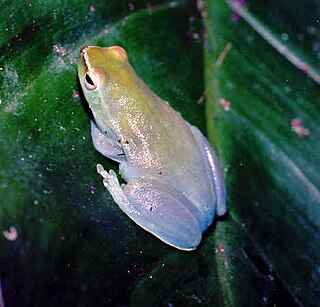 W
WSphaenorhynchus lacteus, the Orinoco lime treefrog or greater hatchet-faced treefrog, is a species of frog in the family Hylidae. It is a widely distributed species found in the Orinoco and Amazon basins in Venezuela, the Guianas, Colombia, Brazil, Ecuador, Peru, and Bolivia. It also occurs in Trinidad and Tobago.
 W
WSpirorbis is a genus of very small polychaete worms, usually with a white coiled shell. Members of the genus live in the lower littoral and sublittoral zones of rocky shores. Spirorbis worms usually live attached to seaweeds, but some species live directly on rocks, shells or other hard substrates. Spirorbis was once thought to have a fossil record extending back into the Early Paleozoic, but now all pre-Cretaceous spirorbins are known to be microconchids. The earliest members of genus appeared in the Miocene, but Oligocene finds may also be possible. The genus contains the following species:Spirorbis borealis Daudin, 1800 Spirorbis corallinae De Silva and Knight-jones, 1962 Spirorbis cuneatus Gee, 1964 Spirorbis granulatus Spirorbis incongruus Spirorbis inornatus L'hardy and Quievreux, 1962 Spirorbis knightjonesi Desilva, 1965 Spirorbis lineatus Spirorbis marioni (Caullery and Mesnil, 1897) Spirorbis medius Spirorbis moerchi Spirorbis nakamurai Spirorbis quadrangularis Spirorbis quasimilitaris Bailey, 1970 Spirorbis rupestris Gee and Knight-jones, 1962 Spirorbis semidentatus Spirorbis similis Spirorbis spirorbis (Linnaeus, 1758) Spirorbis steueri Sterzinger, 1909 Spirorbis tridentata Levinsen, 1883 Spirorbis variabilis Spirorbis violaceus
 W
WTakydromus is a genus of lizards, commonly called grass lizards or oriental racers. Species of the genus Takydromus are endemic to a large part of Asia. Members of this genus are noticeable because of their slender appearance and their agile movements. The word takydromus derives from Greek ταχυδρόμος (takhudromos), "fast-running", from ταχύς (takhus), "swift" + δρόμος (dromos), "course, race".
 W
WTakydromus sexlineatus, the Asian grass lizard, six-striped long-tailed grass lizard, or long-tailed grass lizard, is an arboreal, diurnal species of lizard. The tail length is usually over three times the body length in this species.
 W
WTeius teyou, also called the four-toed tegu, is one of the most common South American lizards. It belongs to the genus Teius and the family Teiidae.
 W
WThe racket-tailed treepie is an Asian treepie, a member of the crow family, Corvidae.
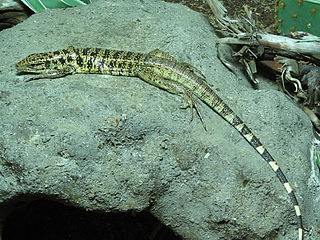 W
WTupinambis is a lizard genus which belongs to the family Teiidae and contains eight described species. These large lizards are commonly referred to as tegus. T. merianae, T. rufescens, and T. teguixin are popular in the pet trade. They are primarily found in South America, although T. teguixin also occurs in Panama.
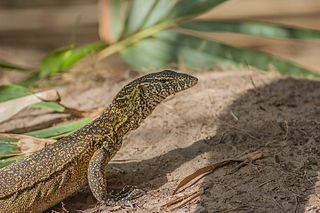 W
WThe West African Nile monitor is a species of monitor lizard that is native to West African forests and adjacent savannah. It has also been introduced to Florida, United States, where it is considered invasive.
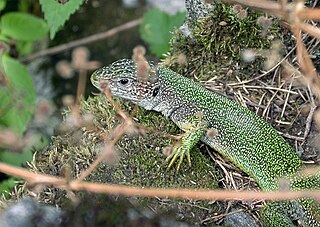 W
WThe western green lizard is a wall lizard of the family Lacertidae.
 W
WThe white-necked crow is the largest of the four Caribbean corvids. It is endemic to the island of Hispaniola. It was formerly also found on Puerto Rico, but is extirpated there, due to considerable forest clearance and hunting.
 W
WThe white-tailed tropicbird (Phaethon lepturus) is a species of tropicbird. It is the smallest of three closely related seabirds of the tropical oceans and smallest member of the order Phaethontiformes. It is found in the tropical Atlantic, western Pacific and Indian Oceans. It also breeds on some Caribbean islands, and a few pairs have started nesting recently on Little Tobago, joining the red-billed tropicbird colony. In addition to the tropical Atlantic, it nests as far north as Bermuda, where it is locally called a "longtail".
 W
WThe African clawed frog is a species of African aquatic frog of the family Pipidae. Its name is derived from the three short claws on each hind foot, which it uses to tear apart its food. The word Xenopus means "strange foot" and laevis means "smooth".
 W
WThe yacare caiman, also known commonly as the jacare caiman, Spanish yacaré, Paraguayan caiman, piranha caiman, red caiman, southern spectacled caiman, jacaré in Portuguese, and îakaré in Old Tupi, is a species of caiman, a crocodilian in the family Alligatoridae. The species is endemic to Argentina, Bolivia, Brazil, and Paraguay. Brown in color and covered with dark blotches, males grow to a total length of 2–3 m (6.6–9.8 ft) and females to 1.4 m (4.6 ft). Typical habitats of this caiman include lakes, rivers, and wetlands. Its diet primarily consists of aquatic animals, such as snails, and occasionally land vertebrates. Mating occurs in the rainy season and eggs hatch in March, with young fending for themselves as soon as they hatch. The yacare caiman was hunted heavily for its skin to use for leather in the 1980s, which caused its population to decrease significantly. However, trading restrictions placed since have caused its population to increase. Its population in the Pantanal is about 10 million, and it is listed as least concern on the IUCN Red List.